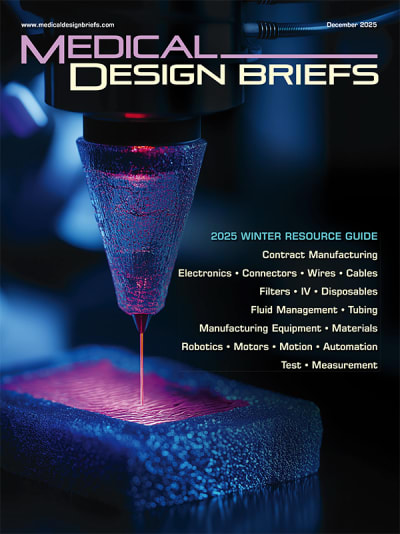A medical device undergoing design and classified as sterile will be confronted with various obstacles, not the least of which is how to determine and maintain its proposed Sterility Assurance Level (SAL) as it approaches its ultimate goal: delivery to market.
Sterility assurance, the concept of ensuring that a product meets the required label claims as stipulated by the Food and Drug Administration (FDA), should be placed at the forefront or as close as possible to the initial phase of the design to ensure that unexpected issues do not lead to costly interruptions. In addition, sterility assurance issues should be reviewed periodically during the design process to ensure that the end product will continue to meet this claim.
Within the course of its development, a medical device may face various unexpected issues that must be addressed if the proposed sterility assurance level is to be maintained as initially designed.
Unexpected interruptions can include: (1) undesirable product results as they impact sterilization dose; (2) microbial contamination issues, which cannot be immediately resolved prior to market release; and (3) environmental, manufacturing, and/or Clean Room issues, which require immediate attention.
Note: Risk Management should be reviewed carefully to make sure issues raised in this standard are evaluated as they pertain to the medical device. The contents of this standard are beyond the scope of this technical brief and should be thoroughly reviewed in order to determine each product’s specific risk assessment.
Undesirable product results. During the design process, raw materials, chemical compositions, packaging configurations, and/or the manufacturing process can contribute to the product’s bioburden, the culmination of the microbiological load of any or all sub-parts or of the finished medical device. Furthermore, bioburden can carry the total microbiological load of the medical device as well as resistant strains, which can adversely
impact the Sterility Assurance Level (SAL), as it applies to sterilization dose setting.
Sterilization dose setting is best described as the testing, enumeration, and, in most cases, the characterization of the microbial flora coupled with resistance studies in order to determine the prescribed dose that must be administered to ensure the product meets Sterile label claim as stipulated in international standards, pharmaceutical standards, the United States Pharmacopeia, and the FDA.
Sterilization can be accomplished using various commercial methods, including ethylene oxide sterilization, radiation sterilization, steam sterilization, and a series of other accepted and practiced methods. These methods require a clear understanding of the product bioburden, the source of the bioburden load, and a method for the enumeration and/or control of the bioburden.
The sterility assurance program should evaluate all variables for their bioburden impact on the final medical device design, in order to ensure minimal process interruptions and the lowest sterilization dose possible.
Microbial contamination. Prior to commencing with manufacturing operations, the manufacturer should perform an environmental assessment of the manufacturing site. This assessment may uncover key contamination factors that can adversely affect the medical device beyond the issue of sterilization. The device may exhibit efficacy concerns, discoloration, embrittlement, and odor, to name a few. These contamination factors may or may not affect sterilization dose, but could pose other problems later on. There are various vectors that contribute to contamination. Some commonly known vectors are listed here:
- Air Systems, including High Efficiency Particulate Air (HEPA) systems, return systems, HVAC systems, and Compressed Air Systems
- Surface Substrates, which can include tables, manufacturing equipment (conveyor belts), bins, totes, and any other equipment that may come in contact with the in-process and/or finished product.
- Personnel, which carry the largest impact on the medical device if manual assembly is required. The personnel vector can include hands and clothes.
- Apparel, such as lab coats, safety equipment, head covering, gloves, and shoe covers can, if not properly monitored and maintained, result in high contamination vectors.
- Manufacturing equipment and materials such as extrusion equipment and corrugate can carry a high level of contamination.
- Characterization of the microbial flora (microbial strains that exist in the manufacturing environment and the medical device) should be known. The microbial flora can endanger the sterilization process. For example, a product may exhibit sterility positives following the sterilization process. Microbial flora characterization is, therefore, not only the bioburden, but also the resistance of the microbial population. Control of the microbial flora during the design process will assist in achieving a certain predetermined sterility assurance level. Methods to achieve control will be discussed in the Environmental, Manufacturing, and Clean Room Section.
Environmental, Manufacturing, and Clean Room Issues. When scale-up manufacturing begins, a host of issues may arise that impact sterility assurance. The manufacture of a device in a controlled setting, as related to a trial run, may not have the same microbial bioburden as the same device in a large manufacturing setting. Select testing will help to identify what actions to take to minimize increased bioburden levels. Testing can include: (1) Product (i.e., raw material, in-process components, and finished medical devices) should be tested to monitor the contamination level; (2) Clean Room systems (i.e., HVAC systems, return systems, High Efficiency Particulate Air systems, and compressed air systems) should be monitored to minimize contamination to the product; and (3) Manufacturing processes (i.e., conveyor belts, tables, extrusion, injection molding, and associated equipment) should be evaluated for the contamination impact.
This work was done by Dynatec Scientific Labs, El Paso, TX. For more information, Click Here .



